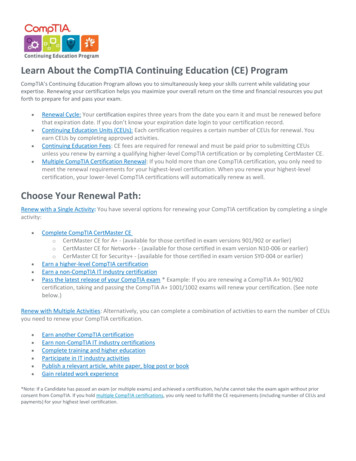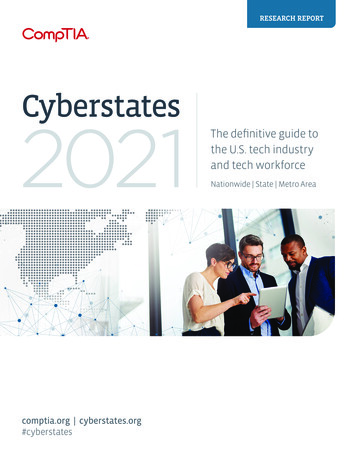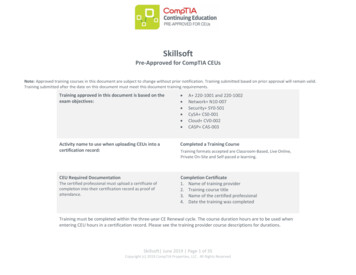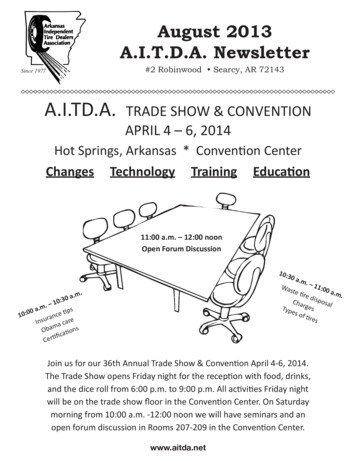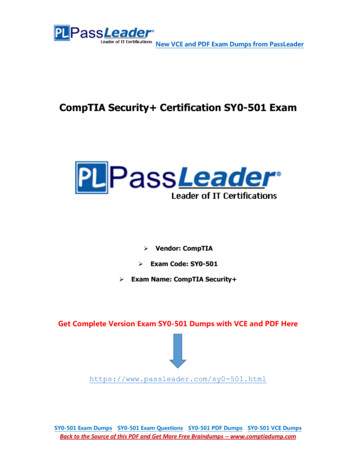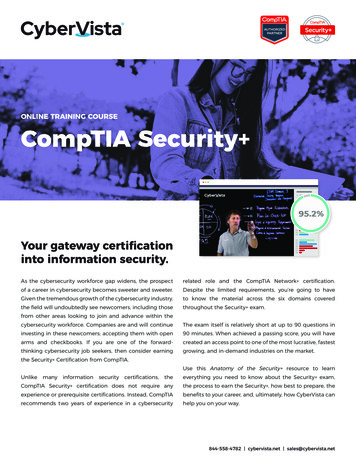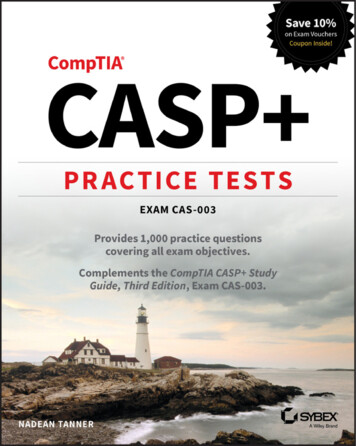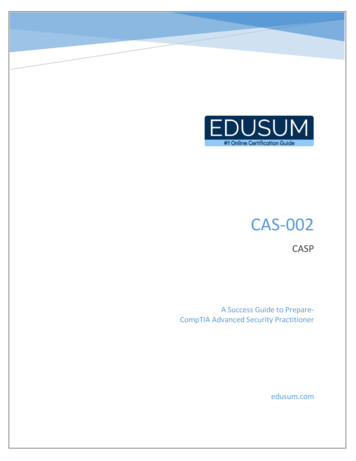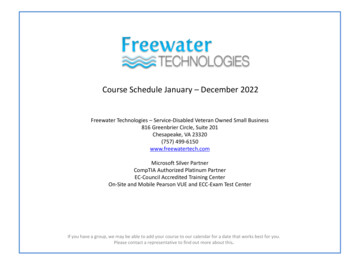
Transcription
Comptia security 501 study guide pdf
The official comptia security study guide (exam sy0-501) ebook pdf. Comptia security 501 study guide pdf. Comptia security study guide exam sy0-501. Comptia security study guide sy0-501 pdf free download. Comptia security get certified get ahead sy0-501 study guide. The official comptia security study guide (exam sy0-501). Comptiasecurity get certified get ahead sy0-501 study guide pdf. Comptia security 501 study guide.About The main objectives of this repo This is a 'Open Source Study Guide' for Security SY0-501, gathering as many information as possible from many sources on internet to ensure to cover all topics presented on exam. The second objective is to help you pass the exam without paying any expensive training courses and also contribute to infoseccommunity Rights and Perms, Sales Group -- Rights and Perms Attribute-based Access Control (ABAC): Users can have complex relationships to applications and data Access may be based on many different criteria ABAC can combine and evaluate multiple parameters Resource information, IP address, time of day, desired action, relationship to thedata, etc Rule-based Access Control: Generic term for Following Rules Conditions other than who you are Access is determined through system-enforced rules System administrators, not users The rule is associated with the object System checks the ACLs for that object Rule examples Permitting access for an account or group to a networkconnection at certain hours of the day or days of the week Only Chrome browsers may complete this web form Rule Based Access Control (RBAC) introduces acronym ambiguity by using the same four letter abbreviation (RBAC) as Role Based Access Control. Under Rules Based Access Control, access is allowed or denied to resource objects based ona set of rules defined by a system administrator. Access is defined by ACL, Access Control List. Implicity deny prevents access unless specifically permitted. File system security Store files and access them Hard drives, SSDs, flash drives, DVDs Part of most OS's Accessing information ACL - Access Control List Group/User rights and permissions Canbe centrally administred and/or users can manage files they own Encryption can be built-in The file system handles encryption and decryption Database security Databases have their own Access Control Username, password, permissions Encryption may be an option Most databases support data encryption Data integrity is usually an option No datais lost because of a fault Part of the database server operation Applications can provide a secure front-end Prevent SQL injections and inappropriate access to data Triple AAA Two most popular protocols of triple AAA is RADIUS and TACACS , providing centralized Authentication, Authorization and Account management and registry logging forcomputers to connect and use a network service securely. RADIUS or TACACS server resides on a remote system and responds to queries from clientes such as VPN clients, wireless access points, routers and switches. How RADIUS and TACACS works: [Authentication] - The server authenticates username and password [Authorization] - Determine if a user is allowed to connect to the client [Accounting] - Log the connection RADIUS - Remote Authentication Dial-In User Service Used for network access Radius Server: Get the stack of usernames and passwords (can be MySQL, AD/DS, etc.) Radius Client: The Gateway between users and servers Radius Supplicant: The person thatwant to authenticate RADIUS can use up to 4 different ports: Ports used by RADIUS :-: - 1812 1813 1645 1646 TACACS - Terminal Access Controller Access-Control System Plus Is really good to manage a big number of network devices. Provide the same as RADIUS but the service decouple the authorization from the authentication. Managesthe authorization better than RADIUS. Uses TCP Port 49 TACACS encrypts all information between the client and server. RADIUS only encrypts the passwords Authentication Methods PAP - Password Authentication Protocol Is the oldest authentication method. PAP sends username and password in the clear / plaintext CHAP - Challenge HandshakeAuthentication Protocol Uses a hash value of challenge message to authenticate NTLM - NT LAN Manager for Windows Similar to the CHAP; uses a challenge hashed message with a different process than CHAP NTLM is vulnerable to a credentials forwarding attack (use credentials of one computer to gain access to another) - Most secure systemsmigrate to Kerberos Kerberos for Active Directory Domain Services (AD DS) Authenticator (Encrypted with user's password) TGT (Encrypted with KDC's key) [ticket-grant-ticket] Resource Ticket (Encrypted with Resource's key by the KDC and issued to the user) Resource Ticket used by Client to access the resources Uses Port 88 SAML - SecurityAssertion Markup Language Used exclusive for Web Application LDAP - Lightweight Directory Access Protocol Query Directories: Structured language that allows one computer to go into somebody's directory and query, update. Uses TCP/UDP Port 389 Single Sign-On Authenticate one time - gain access to everything LAN: Windows ActiveDirectory is dominant for security SSO SAML: SSO for Web Application / used to manage multiple apps using a single account PPP - Point-to-Point Protocol In computer networking, Point-to-Point Protocol (PPP) is a data link layer (layer 2) communications protocol between two routers directly without any host or any other networking in between. Itcan provide connection authentication, transmission encryption, and compression. Transport layer protocol Initiate connection Get address information Make connection Poor authentication mechanisms: PAP - password authentical protocol (passwords in the clear) CHAP - Challenge handshake authentication protocol - (use of hashing) MS-CHAP(Microsoft CHAP) Accounts Types User accounts This is the account type most people will use Storage and files can be private to that user No privileged access to the OS Shared accounts Used by more than one person/guest login, anonymous login Very difficult to create an audit trail Password management becomes harder Best practice is simplyDON'T use these dumb type of accounts Service accounts Used exclusively by services running on a computer No interactive/user access(ideally) Web server, database server, etc Access can be defined for a specific server Web server rights and permissions will be different than a database server Commonly use usernames and passwords using policyto determine best passwords practices Privileged accounts Administrator, Root Complete access to the system This account should NOT be used for normal administration Needs to be HIGHLY secured - Strong passwords, 2FA, scheduled password changes User Account Management Least privilege Rights and permissions should be set to the bareminimum You only get exactly what's needed to complete your objective This is apply to all users in the organization All users accounts must be limited Applications should run with minimal privileges Don't allow users to run with administrative privileges Limits the scope of malicious behavior Privilege creep - when someone get a bunch of newprivileges unecessarily; gradual accumulation of access rights beyond what an individual needs to do his or her job. Continuous Access Monitoring Monitoring all users account activity Track Log on and Log off activity Track file access Shared Accounts BAD!!! Multiple Accounts Use different user/pass Use least privilege - enough necessary toaccomplish task Monitor and log activity of users with multiple accounts (LOG EVERYTHING) Avoid default usernames on user accounts Access Control Technologies Proximity Cards Close range card - contactless smart card Passive deivce No power in the card - powered from the reader Not a large data storage device Often used as an identifierKeycard door access, library cards, payment systems The identifier is linked to data stored elsewhere Smart cards Integrated circuit card - contact or contactless Common on credit cards - Also used for access control Must have physical card to provide digital access - a digital certificate Multiple factors - use the card with a PIN or fingerprintBiometrics Fingerprints Facial Recognition Vocal Recongnition Can lock and unlock devices Use to configure applications Biometric acceptance rates: False acceptance rate (FAR) - Type II Likelihood that an unauthorized user will be accepted (This would be bad) False injection rate (FRR) - Type I Likelihood that an authorized user will be rejectedCrossover error rate (CER) The rate at which FAR and FRR are equal Adjust sensitivity to equalize both values Used to quantitatively compare biometric systems Type II and Type I errors - In statistical hypothesis testing, a type I error is the rejection of a true null hypothesis (also known as a "false positive" finding or conclusion), while a type II erroris the non-rejection of a false null hypothesis (also known as a "false negative" finding or conclusion). FAR and FRR can apply to many softwares that uses authentication and authorization methods. Token generators Pseudo-random token generators - useful authentication factor Carry around a physical hardware token generator Use software-basedtoken generator on your phone HOTP - HMAC-based One-time Password algorithm One-time passwords Use them once, and never again Once a session, once each authentication attempt Keyed-hash message authentication code (HMAC) The keys are based on a secrete key and a counter Token-based authentication The hash is different every timeHardware and software tokens available TOTP - Time-based One-Time Password algorithm Use a secret key and the time of day No incremental counter Secret key is configured ahead of time Timestamps are synchronized via NTP Timestamp usually increments every 30 seconds Put in your username, password, and TOPT code One of the morecommon OTP methods used by Google, Facebook, Microsoft, etc Certificate-based authentication Smart card PIV (Personal Identity Verification) card US Federal Government smart card Picture and identification information CAC (Common Access Card) US DoD smart card Picture and ID IEEE 802.1X Gain access to the network using a certificate ondevice storage or separate physical device Account Policy Enforcement Windows Group Policy Management Apply security and admin setting across many computers Different than NTFS or Share permissions that control the use of the OS Linked to Active Directory administrative boundaries Sites, Domains, Organization Units (OUs) Define byGroups, Locations, etc Group Policy Management Editor - Windows Administrative Policies Remove add or Remove Programs Prohibit changing sounds Allow font downloads ONly allow approved domains to use ActiveX controls without prompt Security Policies Specify minimum password length Require smart card Maximum security log size Enforceuser login restrictions Password Security Complexity Length and character requirements Expiration Password history Local Security Policy - Password Policy - Windows Enforce Password History: determine the number of new unique passwords [1-24] Maximum Password Age: Password age [1-999 days] Minimum Password Age: Limit until requestpassword change [1-998 days] Maximum Password Lenght: [1-20 characters] Password Complexity: Not contain user account name or parts of full name At least 6 characters lenght At least three of four categories: Uppercase [A-Z] Lowercase [a-z] Base 10 digits [0-9] Non-alphabetic characters [!,@,#, ,.] Account Lockout Policy Account LockoutDuration: Time (in minutes) for a locked-out account [0-99,999] Account Lockout Threshold: Number of failed logon attempts [0-999] Reset Account Lockout Duration: Period of time that must elapse before the account lockout counter is reset to 0 bad logon attempts. [1-99,999] Local Security Policy applies policies for the host machine/local. GroupPolicy Management applies policies for the organization through Active Directory Domains, Groups, OUs, etc. 1. Good practices - Password complexity AVOID single words or obvious passwords Name of dog, parent, partner Use upper, lower case and special characters on each password At least 8 characters Consider a phrase or set of words Preventpassword reuse System remember password history, requires unique passwords 1.1 Good practices - Password expiration and recovery All passwords should expire Change every 30 days, 60 days, 90 days Critical systems might change more frequently Every 15 days or every week The recovery process should NOT be trivial! Some organizations havea very formal process 1.2 Good practices - Account lockout and disablement Always turn on the policy of Account Lockout to avoid brute-force try out Disable accounts is better than Delete account; Often users save data, encryption keys, etc; Makes easier to retrieve this information. Group Policy Objects (AD DS) Set of rules that allow anadministrator granular control over the configuration of objects in Active Directory, including user accounts, operation systems, applications and other AD objects. Can apply over multiple domains, groups and OU's. Permissions - Windows NTFS permissions are granted to users and groups on folders and files. NTFS Permissions - Folder Full Control Anything Modify - Read, Write and Delete Files and Subfolders Read/Execute - See contents and Run Programs List Folder Contents - See Contents of Folders and Subfolders Read - View Contents and Open data files Write - Write to Files and Create new files and folders NTFS Permissions - File Full Control - Anything Modify - Read, Write and Deletefiles Read/Execute - Open and Run the file List Folder Contents - Open the file See Contents of Folders and Subfolders Read - Open the file Write - Open and Write to the file Deny is stronger than allow. Moving and Copying NTFS Objects Copy and Move from drive X: to Y: - will take the NTFS permissions of the destination drive. Copy from drive X:to the same drive X: - will loose the NTFS permissions. Move from drive X: to the same drive X: - will inheritance the NTFS permissions Permissions - Linux Linux has three permissions and they can be set for the owner, group or other. r read - open a file, view a file. w write - edit a file, add or delete files for directories. x execute - run a file,execute a program or script, CD to a different directory. Owner Group Other rwx rwx rwx Viewing the permissions on Linux command-line: -rwxrwxr-x 1 user user 31337 Feb 11 13:13 File Using chmod chmod is the command and system call which is used to change the access permissions of file system objects on Unix and Unix-like OS. Clear out thepermissions of the File to have no read, write and execute permissions on Other: (The flag equals to nothing[o ] deny the permissions) -rwxrwxr-x 1 user user 31337 Feb 11 13:13 File -rwxrwx--- 1 user user 31337 Feb 11 13:13 File Giving read and write permissions to Group: -rwx---r-- 1 user user 31337 Feb 11 13:13 File -rwxrw-r-- 1 user user 31337Feb 11 13:13 File Giving all permissions to everybody(Owner,Group and Other): -rwx---r-- 1 user user 31337 Feb 11 13:13 File -rwxrwxrwx 1 user user 31337 Feb 11 13:13 File Using chmod on oldschool way: The chmod command will take the octal value and combine them to associate the permissions on three different positions for the Owner, Groupand Other/Everyone. This boils down to a simple binary rule: 0 off 1 on. Octal Binary Permissions 0 000 --- 1 001 --x 2 010 -w- 3 011 -wx 4 100 r-- 5 101 r-x 6 110 rw- 7 111 rwx If you want to give all permissions to a group for example, the number will be 7 (4 2 1). Read Write Execute r-- -w- --x 4 2 1 Examples: Giving read, write and executepermission to everybody: -rwx---r-- 1 user user 31337 Feb 11 13:13 File -rwxrwxrwx 1 user user 31337 Feb 11 13:13 File Giving all permissions to the owner, read and write to group and no permissions to other/everyone: -r-x---r-- 1 user user 31337 Feb 11 13:13 File -rwxrw---- 1 user user 31337 Feb 11 13:13 File Linux - File Ownership using chown(change file owner and group) -rwxrwxrwx 1 user001 user001 31337 Feb 11 13:13 File -rwxrwxrwx 1 root user001 31337 Feb 11 13:13 File The chown command requires sudo Linux - Changing the Password using passwd 5. Risk Management Risk management is the identification, evaluation, and prioritization of risks followed by coordinated andeconomical application of resources to minimize, monitor, and control the probability or impact of unfortunate events or to maximize the realization of opportunities. Defining Risk Vulnerability: A weakness; System flaw. Threat: Exploit vulnerabilities to harm assets. Risk: The likelihood of a THREAT exploiting a VULNERABILITY, resulting in a loss.Formula: THREATS x VULNERABILITY RISK OR THREATS - VULNERABILITY RISK 1) Asset: Is a part of an IT infrastructure that has a value. You can measure value either tangibly or intangibly. A gateway router is an example of an asset with tangible value, if it fails, you can easily calculate the cost to replace the router. Example of assets:Asset Info. Servers The computers that offer shared resources Workstations The computers users need to do their job Data The stored, proprietary information an organization needs to operate Applications Specific programs an organization needs to use Personnel The people who work in an organization Wireless access Wireless access to thenetwork Internet services The public or private-facing resources an organization provides to customers, vendors, or personnel via the Web or the Internet applications 2) Probability Probability means the likelihood - over a defined period of time - of someone or something damaging assets. Quantitative likelihood: based on numbers and data, can bemore easy to measure anually. Qualitative likelihood: is more subjective like - LOW MEDIUM HIGH. 3) Threat actors A threat actor can be a malicious person, such as a hacker accessing corporate secrets. The exam cover six types of threat actor: Script Kiddies Can be external or internal Not Very sophisticated Runs pre-made scripts without anyknowledge of what's really happening Hacktivists Hacker Activist A hacker with a purpose - social change or a political agenda Can be sophisticated DoS, Web Site Defacing, Information Disclosure, Leaking private documents. Organized Crime Professional Criminals Motivated by Money Very sophisticated Crime that's organized One person HacksOne person Manages the exploits One person Sells the data Another Handles customer support Lots of capital to fund hacking efforts operational Nation States / APT Governments - National Security, Job Security; Always an external entity Highest sophistication Military control, utilities, financial control Constant attacks, massive resources AdvancedPersistent Threat Insiders Has institutional knowledge Attacks can be directed at vulnerable systems allowing the bad guy what, when and how to hit Can be sophisticated Extensive resources Competitors Many different motivaions - Espionage, harm reputation High level of sophistication Many different intents Shut down your competitor during anevent Steal customer lists Corrupt manufacturing databases Take financial information Risk Assessment NIST SP 800-30 CVE (Common Vulnerabilities and Exposures) Nessus scanner Penetration Testing Environmental: Natural disasters outside the control of humans Manmade: Any threat that is not environmental Internal: Threat generated byinternal sources, usually an insider to the organization External: Threat generated from outside your infrastructure After identified and analyzed risk, you must decide how to responde to the risks produced as a result of the analysis. 1) Risk Mitigation Is an attempt to reduce the risk, or at least minimize its effects on an asset. 2) Risk Transference OrRisk Sharing, deals with risk by sharing with third-party. Example buying insurance to protect against natural disasters. 3) Risk Acceptance Means the organization has implemented controls and some risk remains (residual risk). Remember that risk can never be completely eliminated. Residual risk is what risk remains after all mitigation andreduction strategies have been implemented. 4) Risk Avoidance Means thtat the organization could choose not to participate in activities that cause unnecessary or excessive risk. Change management Provide more uptime availability and decrease the risk for the entire organization. How to make a change Upgrade software, change firewallconfiguration, modify switch ports One of the most common risks in the enterprise Often overlooked or ignored Have clear policies Frquency, duration, installation process, fallback procedures Risk Frameworks NIST - Risk Management Framework SP 800-37 ISACA Risk IT Framework Security Controls The cornerstone of IT security is understandingsecurity controls and how to apply them. Administrative Control (People - IT Security) Laws Policies Guidelines Best Practices Technical Control (IT Systems - IT Security) Computer stuff Firewalls Password links Authentication Encryption Physical Control (Physical World) Gates Guards Mantraps Keys Activity Phase Control Types Deterrentcontrol: Deters the actor from attempting the threat. (Warning Sign, SSH Login Banner) Preventive control: Deters the actor from performing the threat. (Fence, Server Locks, Password Complexity, Firewall) Detective control: Recognizes an actor's threat. (Background check, CCTV, IDS/IPS) Compensating: Provides alternative fixes to any of theabove functions Corrective: Mitigates the impact of a manifested threat. (Backups can mitigate a ransomware; IPS can block an attacker) Most of security controls are preventive phase controls Another Security Controls Mandatory Vacation Job Rotation Multi-person Control Separation of Duties Principle of Least Privilege Defense-in-Depth Every ITinfrastructure might be looked at as a series of concentric shells. The location of these shells depends on the types of threats you are mitigating. Defense in Depth uses administrative, physical and technical controls. 1) Physical Controls Door locks, fences, rack locks, cameras, mantraps 2) Technical Controls Hardware and software to keep thingssecure Firewalls, active directory authentication, disk encryption 3) Administrative Controls Policies and Procedures On boarding and off boarding Backup media handling Redundacy Repeating the same controls at various intervals. Diversity Try different set of security controls in a random pattern. Vendor Diversity: Uses several vendors to supplyequipament and services. IT Governance All about rules and requirements applied to an organization that dictate how it conducts business, protects data, and obeys the law. Governance comes in the forms of laws, regulations, internal rules, and industry standards. Influences how the organization conducts IT security. In its most core function is toactually make the right set of security controls. Laws and Regulations Regulations: HIPAA - Health Insurance Portability and Accountability, (USA); Extensive healthcare standards for storage, use, and transmission of health care information. SOX - Sarbanes-Oxley Act, The Public Company Accounting Reform and Investor Protection Act of 2002.GLBA - The Gram-Leach-Bliley Act of 1999; Disclosure of privacy information from financial institutions. Standards Governament Standards: NIST, ISO Industry Standards: PCI-DSS (Payment Card Industry Data Security Standard) Best Practices Common-Sense Frameworks Structure and organization Process management Getting the IT 'product' towork best with the organization Best practices Guidelines and examples for IT management; Cost effective, agile Training - for everyone Industry-Standard Frameworks: COBIT - Framework Control Objectives for Information and Related Technologies Created by ISACA, formerly the Information Systems Audit and Control Association Focus onregulatory compliance, risk management and aligning IT strategy with organizational goals ITIL - Framework Information Technology Infrastructure Library Multiple stages of the IT lifecycle Multiple services: Service Design Service Transition Service Operation Service Strategy Continual Service Improvement By using these industry-specificframeworks, an organization can structure their IT departments to best serve the overall need of the organization. Policies - Document that defines how we're going to be doing something. Define Roles and Responsabilities. Procedures - Step by step process of how to do something. Security controls, Policies and standards help define and build theProcedures. Organizational Standards Have much more detail than policies. Define the acceptable level of performance policy. The security controls come from the policies and standards. Security Policies The Acceptable Use Policy (AUP): Defines what a person can or can not do when using company assets and equipament. (The paper you signbefore entry a job position). An acceptable use policy (AUP) defines what users may and may not do with regard to information systems, including e-mail. Data Sensitivity and Classification Policies: Define the importance or nature of the data. (e.g. Applying labels on the Government, they use Top Secret, Classified, etc). Access Control Policies: Howpeople get access to data or resources What type of data do users have access to. Data access and classification restrictions (It cover a lot of things based on the job type). Password Policy: Password recovery Password retention Bad login attempt Password reuse Complexity Care and Use of Equipament: How you maintain company equipament.Privacy Policy: Are often for customers; defines how your data or usage will be shared with other resoruces. (e.g. Services like Facebook etc). General Security Policies: Social media policies Balance the company reputation with employee participation Extension of your code of conduct Define requirements and expectations Identification as anemployee Personal responsibility Confidential information Public companies are legally bound There's company spokesperson for public comments Personal email policies Qualify the use of email - business use not personal use Prohibit disruptive or offensive use Compliance use Some organizations are legally required to prohibit personal email Theline becomes hazy when browser-based email is used Personnel Management On boarding: New hires or contractors Background check NDA (Non-disclosure agrement) Standard Operation Procedures Specialized Issues (e.g. Clean Desk) Rules of Behavior (e.g. Good AUP) General Security Policies (e.g. Personal Email, Social network.) Off boarding:When the employee leaves the company Disable accounts (never delete an account) Return Credentials Exit interview Knowledge transfer Personnel Policies: Background Check Mandatory Vacation Job Rotation Separation of Duties Multi-person Control Personnel Management Controls Mandatory Vacation: Required Prevents collusion Dependencyissues Makes fraud harder Job Rotation: Redundancy and Backup Allows for cross-training Makes fraud harder Separation of Duties: Requires dual execution (at least two people to do a sensitive function) Multi-Person control: Moren than one person required in a task/function Role-Based Data Controls System Owner: Management level roleMaintains security of the system (defines security policies and backup policies) Defines a system administrator Works with all Data Owners to ensure data security System Administrator: Day-to-day administration of a system Implement security controls Data Owner: Defines the sensitivity of the data Defines the protection of the data Works withSystem Owner to protect data Defines access to the data User: Accesses and uses the assigned data responsibly Has least privileged access to the application and data Privileged: Has special access to data beyond the typical user (additional application and data permissions) Works closely with System Administrators to ensure data security Areamanager, report creation, user and password changes Executive User: Read only access but can look at all business data Responsible for the overall operation of the application Evaluates goals and makes decisions about future directions Risk Management Frameworks A framework is a description of a complex process, concentranting on major stepsand the flows between the steps. Describes the major steps and flows of the complex process of applying security controls in an organized and controlled fashion. Frameworks come from a variety of sources including: Regulatory Non-Regulatory National Industry Standards (Best Practices) Popular RMF National Standard and Regulatory: NonRegulatory: International Standard: NIST Risk Management Framework: Quantitative Risk Assessment Is based on objective data, typically numerical data; Exact values, for instance, can be used to describe impact or loss of an asset. Asset Value (AV) When valuing an asset, consider not only the replacement cost, but also the revenue the assetgenerates, as this will be lost as well if the asset is not available. Example: Asset Cost Repair Revenue Total Router 600 500 x day 2000 x day 3100 Exposure Factor (EF) The percentage of an asset that could be lost during a negative event. Realistically, you will not always lose 100% (1) of the asset; you may lose only 20% (0.2) or 50% (0.5) forexample. Example: Incident Exposure Value Flood 1 (100%) Single Loss Expectancy (SLE) Is the value that's computed simply by multiplying the asset's value by the exposure factor (percentage of loss). Formula: Single Loss Expectancy Asset Value x Exposure Factor SLE AV x EF Example (using data below): AV x EF SLE 3100 1 3100 SLE 3100 (AV) x 1 (EF) 3100 Annualized Rate of Occurrence (ARO) How many times per year you would expect a particularly negative event to occur, resulting
security get certified get ahead sy0-501 study guide pdf. Comptia security 501 study guide. About The main objectives of this repo This is a 'Open Source Study Guide' for Security SY0-501, gathering as many information as possible from many sources on internet to ensure to cover all topics presented on exam.

